NOTICE JANUARY 2025: SOME ROADS IN DEATH VALLEY NATIONAL PARK ARE CLOSED DUE TO DAMAGE FROM FLOODS OVER THE LAST FEW YEARS. PLEASE CONSULT THE NPS WEBSITE FOR UPDATED INFO ON ROAD CLOSURES IN THE PARK.
If you’re planning on taking a day trip to Death Valley National Park in California then you’ve come to the right place. Here we will go through everything you need to know to plan an amazing day in one of the most fascinating landscapes on the planet.
If you’re taking a Death Valley day trip, you’re almost certainly staying in Las Vegas. Death Valley is the perfect getaway from the sex, drugs and rock and roll of the Vegas Strip. Having lived in Las Vegas for a couple years, I have taken many day trips to the park and even spent a few nights there.
Those visits were all pre-Instagram, when the park was still relatively unknown. Even today it’s the most underrated national park in the US for me. In this post we’ll go through how to visit Death Valley as a day trip from Las Vegas.
Note: this article contains affiliate links, which means that should you purchase something or get a quote through them I may make a small commission at no additional cost to you. This helps keep the site running with up to date information. I do not represent Booking.com, GetYourGuide, or Discovercars.com. This is information only and not a recommendation to buy the product mentioned in this article.
Death Valley: What You Need to Know
What is Death Valley?
Death Valley National Park is one of the younger national parks in the United States National Park System, having been designated a park in 1994. It’s also the largest outside of Alaska, encompassing about 3000 square miles. The park is larger than the states of Rhode Island and Delaware.
It’s a land of extremes, containing the lowest point in the US (and one of the lowest on earth) and not far from the highest point in the contiguous US (Mt. Whitney).
Where is Death Valley?
Death Valley is in the Mojave Desert in southern California, about a two hour drive west of Las Vegas and 4.5 hours northeast of LA. From LA a day trip really is not possible. To make a day trip you’ll really have to be staying in Las Vegas, as no other city is close enough to make it worth it.
How do I get to Death Valley?
Driving is your only option if you’re not going with an organized tour. I recommend having your own vehicle for a proper Death Valley experience, especially if you only have one day.
Click here to find a great rate on a rental car in the US here!
If you don’t want to rent a car, however, there are a ton of organized tours from Vegas that will take you to the park and back in one day. Some examples are this full Death Valley day tour from Las Vegas or this day trip that includes stargazing after dark in the park.
What time of year is best for Death Valley?
The best months for Death Valley are October, November, March, and April in my opinion. However, if you want to experience that world famous heat, you can take your chances and go in the summer.
Just keep in mind that you really can’t do anything else if you go in the summer. Heat like what you’ll feel in Death Valley is literally deadly. If you do go in summer, make sure any hiking or walking you want to do is done by 10 AM.
What time should I leave Vegas?
As early as your hangover allows. There are so many things to see, so you will want to be in the park as long as possible!
How much does it cost to visit the park?
There is no entry gate for the park so paying the $30 fee is on the honor system. Stop by the visitors center at Furnace Creek to pay (or you can drop cash in one of the collection points off the main road).
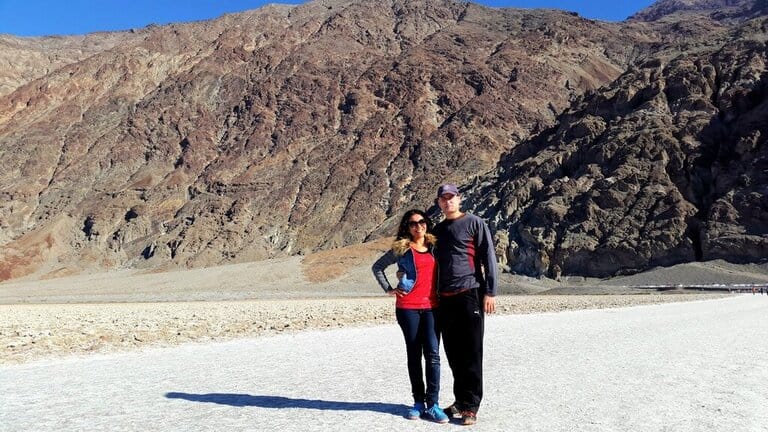
An Introduction to Death Valley
Death Valley is a truly fascinating place. A land of superlatives and extremes, it will leave you mesmerized and wanting more. Let’s start with a few basics about the park.
The hottest place on earth
What comes to your mind when you think of Death Valley? If you’ve never been there you probably don’t really know what it looks like. One word will come to mind though: hot. As in Death Valley is really, really, really hot. In fact, Death Valley is officially the hottest place on planet Earth.
While the temperature reading of 134 degrees F (56.7 C) from 1913 is widely considered to be inaccurate, it is still officially the world record. Even accepting it as bogus, the hottest temperature ever recorded with modern technology is 130.0 degrees F (54.4 C) in Death Valley’s brutal summer of 2021.
But there’s more to Death Valley than just intense summer heat. It’s protected as a US National Park and features some of the most stunning desert landscapes you will ever see.
The valley
Death Valley National Park is huge. It’s more than just the valley itself, but the valley – which runs about 156 miles north-south – is the focal point of the park and where visitors spend the majority of their time.
The valley is flanked by substantial mountains on either side, the Panamint Range to the west and the Amargosa Range to the east. The mountain ranges can be explored on foot in the backcountry but very few people do this.
The park is located in the Mojave Desert, a vast desert ecosystem in the southwestern United States (if you love the desert as much as I do make sure to also check out the Sonoran desert in Arizona and the Moab desert in southern Utah).
Death Valley’s elevation
Badwater Basin in Death Valley sits 282 (86m) feet below sea level. It’s the lowest point in North America and one of the lowest points in the world (though it doesn’t really hold a candle to the Dead Sea in Israel/Jordan at 1411 feet (430m) below sea level). Yet Badwater Basin sits only about 85 miles from 14,505 foot Mt. Whitney (the highest point in the US outside of Alaska) as the crow flies.
You can hike between the two extremes over a course of 135 miles, or run it in the summer if you’re insane. The Badwater Ultramarathon takes place every July in the deadly heat. Only experienced ultramarathoners are allowed to participate though, so better start training now!
In the park itself the highest point is Telescope Peak, at 11,043 ft (3366m). The peak comes straight out the valley and can be hiked relatively easily, though I’ve never done it. The temperature difference between the lowest point in the park and the highest point is substantial. If you visit in the winter, Telescope and surrounding peaks will be covered with snow.

Furnace Creek
Furnace Creek refers to the little village at the center of Death Valley, if you can even call it a village. There is a hotel, a campsite, a few restaurants, the main visitor’s center for the park, as well as a golf course.
Most importantly, the weather station for Death Valley is located in Furnace Creek. So every time you hear about the temperature at Death Valley, it’s taken in Furnace Creek.
It’s about 190 feet below sea level, so still about 100 feet higher than Badwater Basin down the road. No matter what your plans are for your day in Death Valley, it’s worth stopping at Furnace Creek.
The backcountry
Most of the park is in the backcountry, meaning there are no established walking trails or paved roads. Very few people ever get into the backcountry, but if you do you’ll be rewarded with some of the best desert scenery in the world.
And best of all, you’ll be able to visit Racetrack Playa. This is a vast salt flat famous for moving boulders that leave tracks in the salty earth. Only recently was it discovered that the boulders move on average about once every decade through a unique combination of wind, ice, and water.
The truly adventurous might also make it to Barker Ranch, a remote property infamous for being the home of the Manson family. You’ll need a 4WD vehicle to get to these places.
Unfortunately, on a Death Valley day trip from Las Vegas, you simply won’t have time to check out the backcountry.
Wildlife
For as unforgiving as the terrain is in the park, there are a lot of animals you can run into. Some of the bigger ones are desert bighorn sheep, coyotes, and desert tortoises. Also be on the lookout for mountain lions, bobcats, and foxes as well as tons of small mammals and critters.
Native Americans
Amazingly enough, there are Native Americans that have lived – and thrived – in Death Valley for hundreds of years. The Timbisha tribe has called the valley home for over 1000 years and they still maintain a settlement, albeit with air conditioning these days.
If you’re wondering how they managed to survive here before electricity, remember that the highest elevation in the park is high above the valley floor. They simply moved to higher elevations in the brutal summer months.
Top Sites in Death Valley National Park
There are so many amazing things to see in this bad ass park that on a day trip you might not be able to see them all, so let’s go through them in order of amazingness. The map below shows all these spots so you can figure out how you best want to approach hitting them all.
Badwater Basin
As mentioned before, Badwater Basin is the lowest point in North America. It’s a vast salt flat with a tiny little pool of water next to the road. Its name literally means “bad water.”
The water here is twice as salty as the ocean and is not potable. Imagine the disappointment of the settlers in the 1800s crossing the Mojave Desert when they finally found water but couldn’t drink it? Even the horses wouldn’t drink it.
From the parking lot you can walk a little bit along a boardwalk before getting out to the salt flats. Watch where you step as the salty crust of the earth here is very fragile and you don’t want to damage it. At the basin you are right smack in the middle of Death Valley. It’s one of my favorite places to experience the majesty of the park.
Devil’s Golf Course
The Devil’s Golf Course is not actually a golf course. It’s actually a giant field of jagged, salty mounds of earth. I’ve been to many salt flats across the planet and I’ve never seen anything quite like what you see here. It’s truly a fascinating landscape. Be very careful not to fall down here as you will get all cut up!
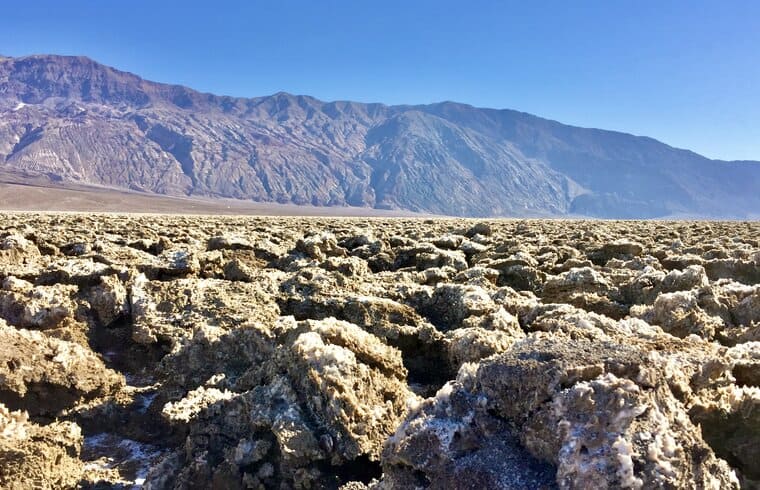
Dante’s View
Perhaps the best viewpoint in the park is Dante’s View. From here, up over 5000 ft from Badwater Basin below you get an amazing view of the entire valley and the mountains to the west. It will be busy, so if you want to get away from most people, take the walk about a mile south along the ridge, where most people don’t venture to.

Artist’s Palette
The Artist’s Palette is an area of colorful badlands. Mounds of dirt and oxidized rock that you can’t believe are purple and green and all shades in between. There is a short scenic drive through it that has a parking lot so you can stop and get out of the car and enjoy the views. The road is one way so be sure not to get on it in the wrong direction.
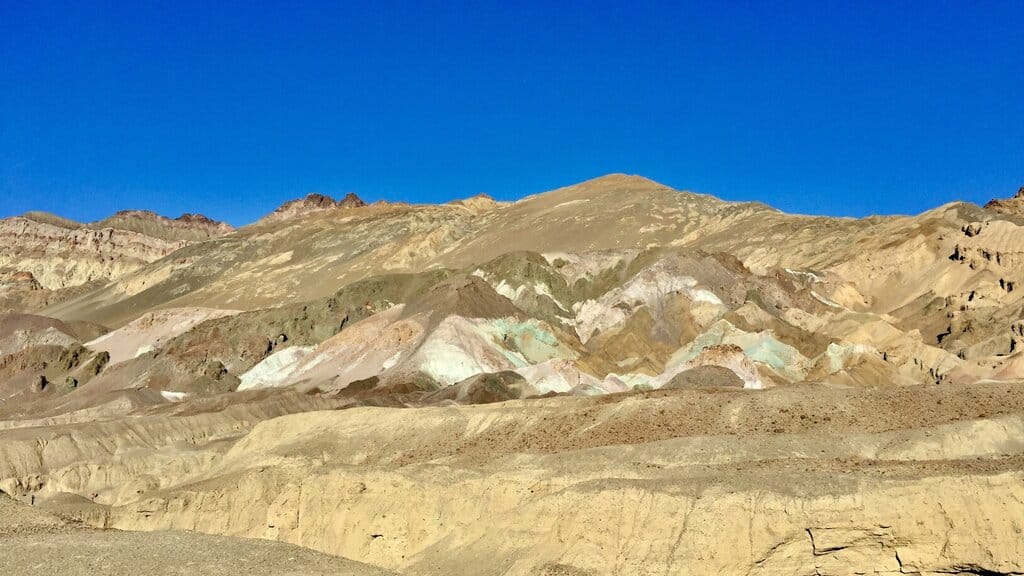
Zabriskie Point
Zabriskie Point is a viewpoint just off the main road with an awesome view of the Death Valley badlands. There are a few hiking trails from the parking lot, so be sure to stay on the trails, as the badlands are very delicate.
Mesquite Flat San Dunes
There are many sand dunes in the United States, but my favorite is probably the Mesquite Flat Sand Dunes in Death Valley. They’re not the biggest dunes by any standard, but they are just beautiful with the sun shining on the mountains in the background.
The cover photo from this post is at these dunes. There’s a parking lot and from there you’re free to wander the dunes on your own, going as far out as you want.
Scotty’s Castle
Tucked away in the northern part of the park, where not too many people venture to is Scotty’s Castle. This “castle” was actually built as a vacation home in the 1920s and remains a lavish residence to this day.
The castle sustained major damage in a flood in 2015 and has been closed for repairs ever since. However, you can still view it from the outside when the road is open (per NPS the road to Scotty’s Castle is closed until at least 2026 while it’s under construction). It’s unknown when – or if – the castle will open to the public again.
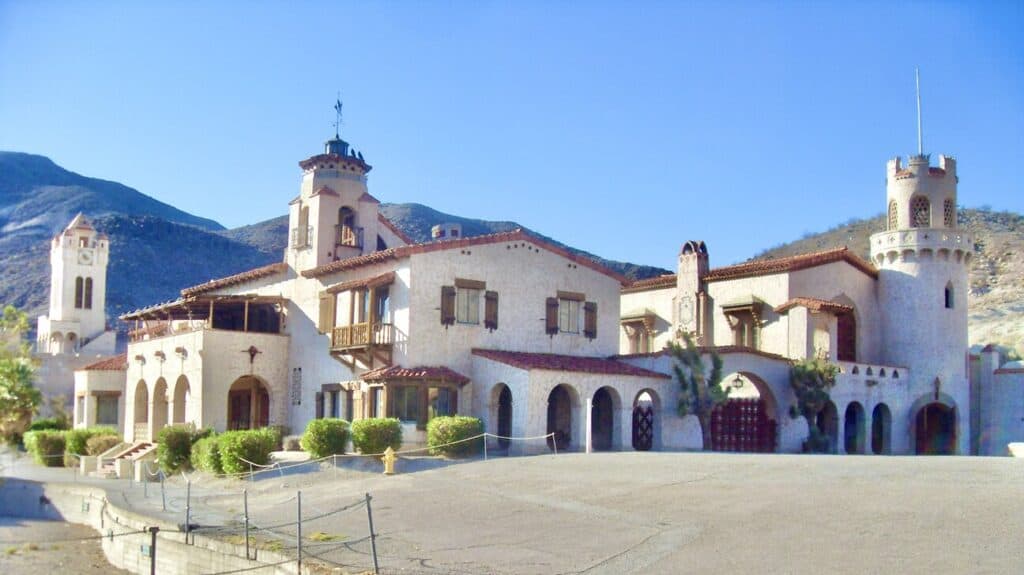
Ubehebe Crater
Another spot off the beaten path is Ubehebe Crater. It is unknown when the crater formed (some think as few as 300 years ago) but we know it was volcanic in nature, caused by steam and gas explosions from the mountains. It’s possible to walk into the base of the crater and check it out from below.
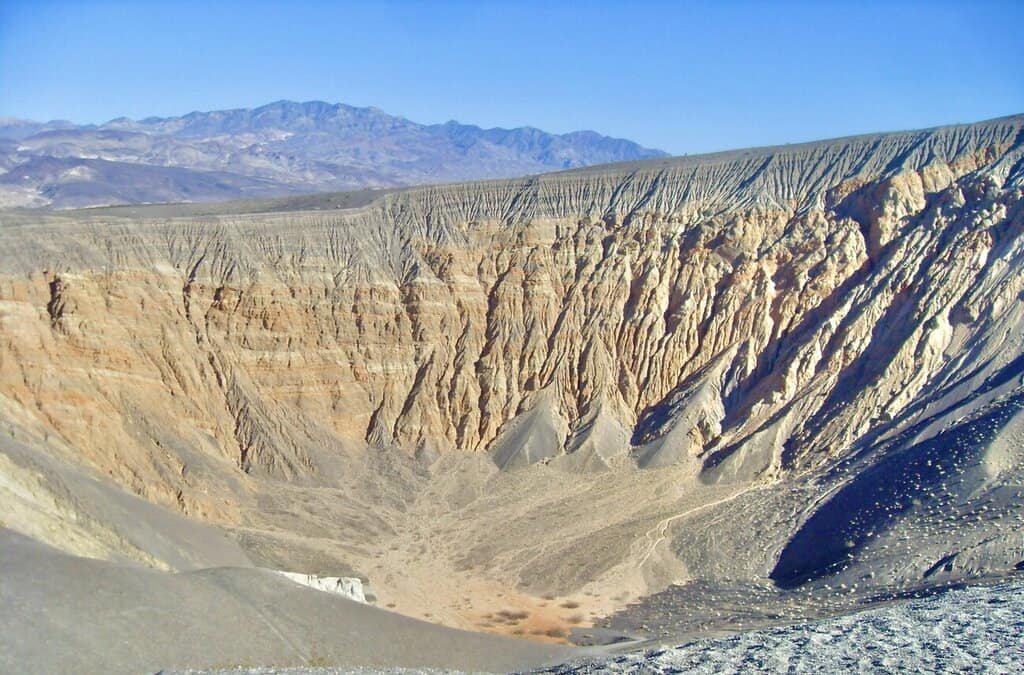
Hiking on a Death Valley Day Trip
Summer hiking in Death Valley can be deadly. Even spring and fall can be dangerous. But luckily there are a lot of short trails that are easily done in an hour or two so you can fit them into a day trip.
This won’t be an exhaustive list of trails in Death Valley by any means, but just a few of the shorter ones you can do in a day mixed in with the sites above (Telescope Peak was already discussed above).
- Desolate Canyon: 3.6 miles round trip through some of the colorful badlands.
- Mosaic Canyon: Short 3.3 mile trail through a narrow canyon. It’s fun because you get to scramble on some rocks.
- Red Cathedral and Manly Beacon Summits: a decent up and down hike from Zabriskie Point through the badlands.
- Coffin Peak: A short, though not very well marked, trail to the top of a mountain near Dante’s View.
- Corkscrew Peak: A difficult hike to the top of a mountain with about a 3000ft elevation gain.
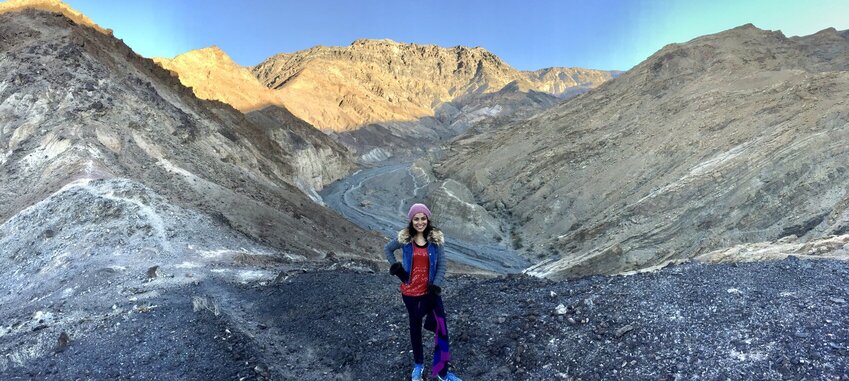
Stay Overnight – Accommodations in the Park
Death Valley is really in the middle of nowhere, so if you’re not making a day trip from Las Vegas you’re going to need to plan where you’ll be spending the night. There are various options in the park and a few other options outside the park.
Budget
If you’re looking to save money on your overnight stay then camping is your only option. There are multiple designated campsites in the park, with the majority of the sites at Furnace Creek. For a full rundown of the campsites and their locations and prices refer to the NPS website linked here.
During the summer months most of the campsites are closed because it’s just too hot to camp. Even during the high season you should not have a problem getting a campsite even if you have not booked one in advance.
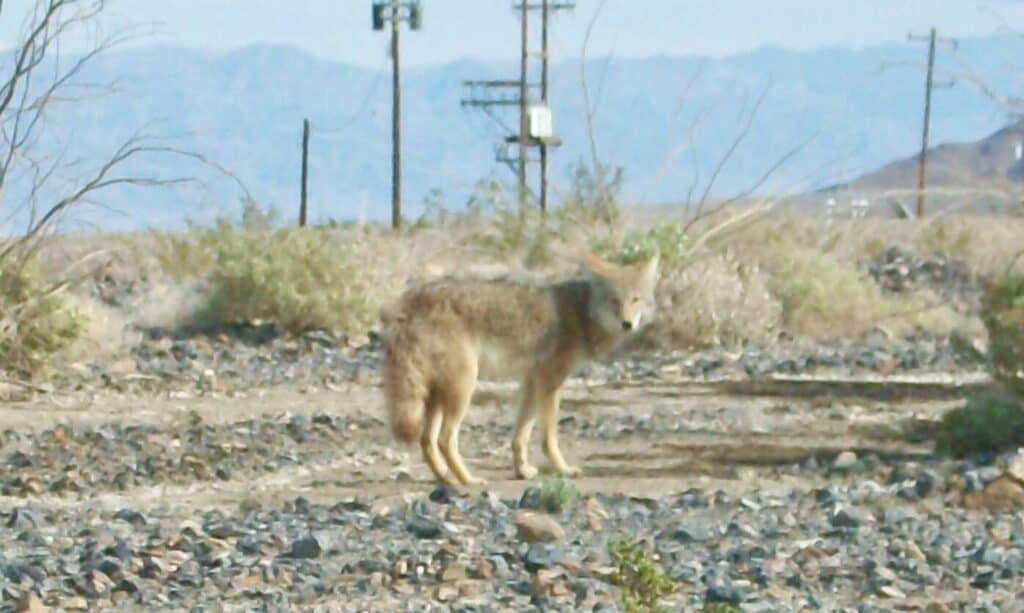
Relatively affordable
The only relatively cheap lodging option in the park is the Panamint Springs Resort. It’s more of a motel than a resort though, and it’s on the far west side of the park, a solid hour’s drive from Furnace Creek.
Expensive but doable
At Furnace Creek you’ll find The Ranch at Death Valley. There is a hotel and some cabins that offer rooms with mountain views. It’s not cheap anymore, but at around $290/night for a room it’s no different than trying to find a hotel in New York or Boston on a weekend. If you go in summer, you can get a room for about $200. For a more private experience, you can also rent a cabin, which will add on about $75 to your stay.
Luxury
If you don’t mind dropping $600 on a hotel room you’ll enjoy staying at The Inn at Death Valley. A luxury resort built in 1927, it’s a true oasis in the desert. I’ve obviously never stayed here but I did try to have dinner one night at the restaurant. They wouldn’t let me in because I was wearing shorts!
Outside the park
There are not a whole lot of towns near Death Valley, just a few as this is a very sparsely populated part of the world. If you don’t want to stay in the park, the town of Beatty, NV is probably your best bet. Just across the border in Nevada, about 45 minutes from Furnace Creek, it’s one of few mining towns that survive to this day.
There are various budget motels in Beatty for you to choose from. There are also a few motels in towns that can really only be described as an intersection between two roads, like Death Valley Junction in California or Amargosa Valley in Nevada.
If you want to stay somewhere with more people there’s always Pahrump, NV. It’s a small city about an hour from Furnace Creek, halfway on the way back to Vegas. But honestly if you’re going to go that far out you might as well just continue on to Las Vegas and stay somewhere that isn’t a dump (sorry people from Pahrump).
It’s up to you, but my recommendation is that if you’re not staying in the park itself, just make it a long day trip from Las Vegas.
Frequently Asked Questions
Why is Death Valley called Death Valley?
Legend has it that some pioneers heading to the west coast in 1849 had a difficult time crossing the valley. They got lost and had to be rescued. While only one of them actually died, they all thought they’d die there and as they climbed the mountains to the west into the Sierra Nevada’s one of them turned back and said “goodbye Death Valley.” The name stuck.
Can you stay overnight in Death Valley?
Yes, there are multiple, though limited, accommodation options within the park. From simple camping to a luxury hotel, you’ll find something that suits you in Death Valley. Though if you don’t want to camp, be prepared to fork over a fair amount of money.
How many days do I need in Death Valley?
It’s easy to see the highlights of Death Valley as a day trip from Las Vegas. 7-8 hours is an adequate amount of time to see the sights and get in a few short hikes. If you want to get into the backcountry, however, you’ll need to stay a bit longer.
Does anyone live in Death Valley?
Yes, humans actually live in Death Valley and have for over 1000 years. The Timbisha tribe has called the valley home for generations. These days, they use air conditioning, but survived for hundreds of years without it.
What are the dangers in Death Valley?
Aside from the obvious danger of extreme summer heat, flash floods are a major concern in Death Valley. It doesn’t rain very often and the soil is not capable of soaking in the rain, leading to flooding and landslides, which can be deadly.
Death Valley Day Trip – Final Word
Death Valley National Park in California is one of my favorite natural sites in the entire world and probably my favorite national park in the United States. Its landscape is unmatched in the US and it’s hard to find something similar in other countries either.
From crusty balls of salt that make up the valley floor to colorful mountains, you’re sure to find something you love in this inhospitable place. And it’s super easy to visit as a day trip from Las Vegas. So take it easy on the partying for one night. Death Valley awaits!

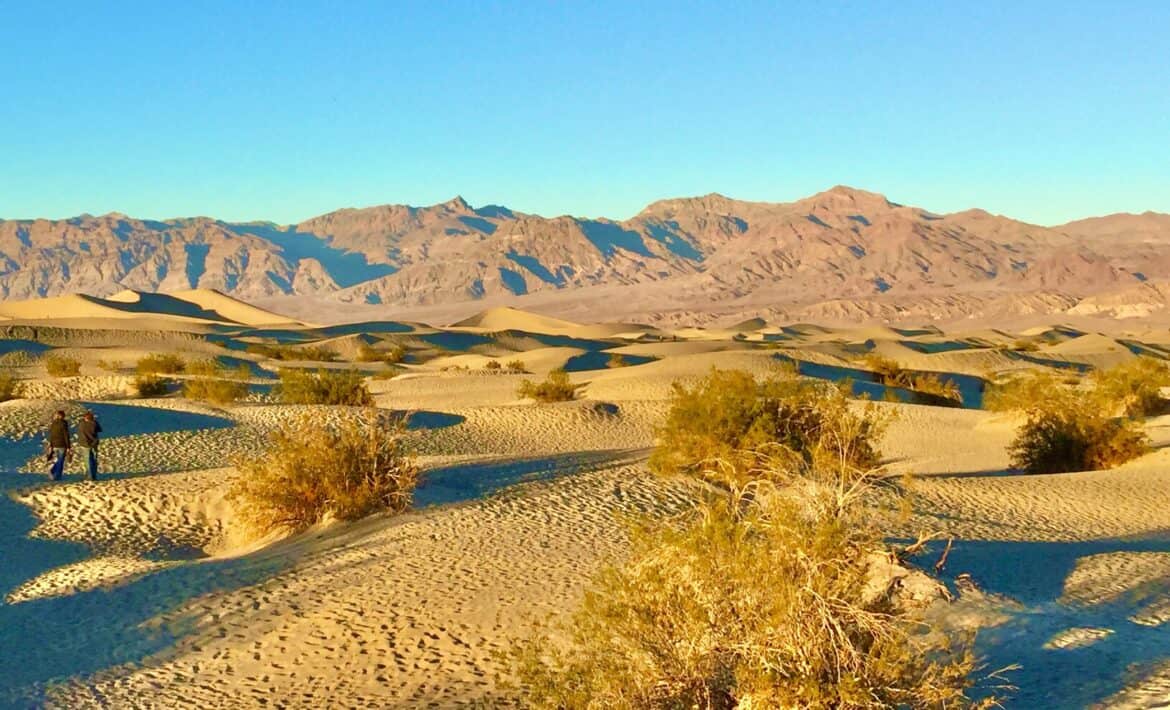
2 comments
[…] Why vacation here: The Death Valley National Park in Eastern California is home to some of the most diverse and intriguing landscapes in the US. It […]
this article is very useful, thank you for making a good article